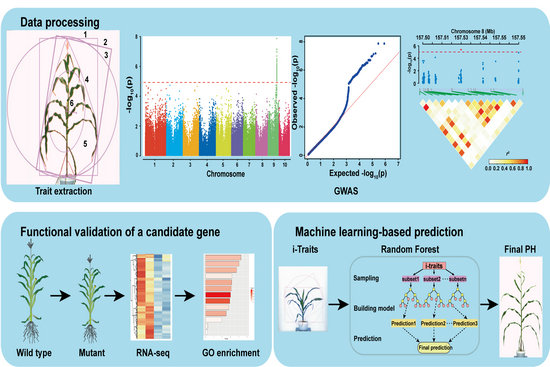Recently, Prof. Li Pu and Prof. Chunyi Zhang’s groups from Biotechnology Research Institute, Chinese Academy of Agricultural Sciences, developed an automated high-throughput phenotyping platform (HTP) to systematically and noninvasively quantify 228 maize inbred lines across all developmental stages and constructed prediction models for final plant height, which provides a valuable tool for dissecting the spatiotemporal formation of specific internodes and the genetic architecture of PH, as well as resources and prediction models that are useful for molecular design breeding and predicting maize varieties with ideal plant architectures. The work,entitled “Integrating high-throughput phenotyping, GWAS and prediction models reveals the genetic architecture of plant height in maize and over”, was published online in Molecular Planton November29th, 2022.
Global agriculture is facing major challenges to ensure global food security, such as the need to breed high-yielding crops adapted to future climates. Plant phenomics offers a suite of new technologies to accelerate progress in understanding gene function and environmental responses. This will enable breeders to develop new agricultural germplasm to support future agricultural production. However, lack of phenotypic data has prevented genetic dissection of key multi-gene agronomic traits in crop genomes.In this study, the scientistsestablished an automated HTP to systematically and noninvasively quantify 77 image-based traits (i-traits) for 228 maize inbred lines across all developmental stages.Time-resolved i-traits with novel digital phenotypes and complex correlations reveal the dynamics of maize growth and hub genes that may play vital roles during maize rapid growth. A prediction model for final plant height was made and assessed in validation across developmental stages. These findings provide a novel approach for dissecting the dynamic genetic architecture of maize throughout the whole growth phases which will be useful for design breeding and genetic improvements in maize.

Figure.High-throughput automatic phenotyping platform for maize across all developmental stages
The associate professor Weixuan Wang, graduate student WeijunGuo, assistant professor Liang Le and graduate student Jia Yu contributed equally to this work. This work was supported by the National Key Research and Development Program of China, National Natural Science Foundation of China, Innovation Program of CAAS, the 2020 Research Program of SanyaYazhou Bay Science and Technology City and Nanfan special project of CAAS.
More details can be found at the link:https://www.sciencedirect.com/science/article/pii/S167420522200435X |